Pros
Cons
Introduction
Front
{{section_header}}{{section.name}}{{/section_header}}

Back
{{section_header}}{{section.name}}{{/section_header}}

Left
{{section_header}}{{section.name}}{{/section_header}}
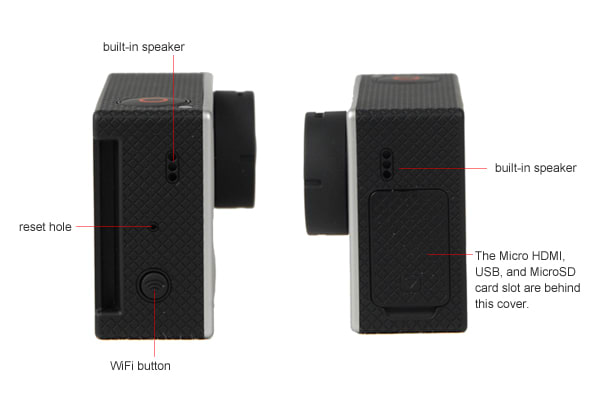
Right
{{section_header}}{{section.name}}{{/section_header}}
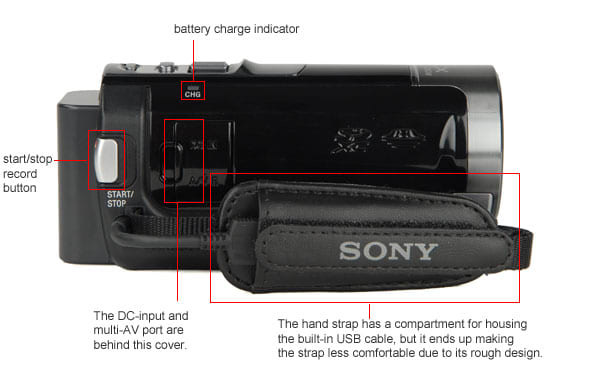
Top
{{section_header}}{{section.name}}{{/section_header}}

Bottom
{{section_header}}{{section.name}}{{/section_header}}

In the Box
{{section_header}}{{section.name}}{{/section_header}}

The GE DV1 includes the following items:
• AC adapter (USB to wall-plug)
• USB extension cable
• wrist strap
• software CD
• quick start guide
• feature guide
• warranty card
Warning: the camcorder does not come with any kind of cable for connecting the DV1 to a television. You must purchase an HDMI cable separately.
Color
{{section_header}}{{section.name}}{{/section_header}}
Most ultracompact camcorders fail our color test for one reason: terrible auto white balance. The GE DV1 fell into this category, as its auto white balance was awful, but the camcorder does offer a few white balance presets that were able to help out its color error. The DV1 does not have a manual white balance feature, however, so its color error score was still not on the level of a regular consumer camcorder. More on how we test color.
At best, the DV1 registered a color error of 7.34 and a saturation level of 81.63%. These numbers were obtained using the incandescent white balance preset. Using auto mode, the camcorder produced colors that were tinted with a large amount of orange-yellow glow, which you can see on the train image below. With auto white balance, the DV1 measured a terrible color error of 14.89.
Most ultracompact camcorders suffer from poor color accuracy in our bright light test due to the white balance issues we discussed above. Unless manufacturers start to improve auto white balance capabilities on these tiny, cheap models (or add a manual white balance mode), we expect this trend to continue.
The DV1 got a boost in this test because of its white balance preset options, although its results were still nowhere near what we'd classify as a "good" color performance. Most ultracompacts do not have white balance presets, so we were somewhat surprised to see them even offered on the DV1. Maybe GE will offer a manual white balance option on the DV1's replacement in the future.
{{comparison_bars title="Color Score Comparison", attribute="Color Score", xLabel="Color Score"}}
Low Light Color
{{section_header}}{{section.name}}{{/section_header}}
The GE DV1 struggled in our low light color test, just as the camcorder had problems with color accuracy in bright light. In the low light test, however, the DV1 did not benefit from any of its white balance preset modes. Using auto white balance, the camcorder registered a color error of 8.54 and a saturation level of 96.61%. More on how we test low light color.
Noise
{{section_header}}{{section.name}}{{/section_header}}
The GE DV1 caught us off guard with a very good noise performance in our bright light test. The camcorder averaged 0.34% noise in this test, which is a good deal better than the competition (that's even a good score for a mid-range or high-end camcorder). More on how we test noise.
In the crops above you can compare the crop from the GE DV1's bright light image with the competition (just click on the more button next to the image). You can see that none of these camcorders produced a very sharp image in bright light, although the Panasonic HM-TA1 is definitely the leader of the pack. The DV1's image is blurry and discolored in comparison.
{{comparison_bars title="Noise Score Comparison", attribute="Noise Score", xLabel="Noise Score"}}
Low Light Sensitivity
{{section_header}}{{section.name}}{{/section_header}}
Ultracompact camcorders often surprise us with good low light sensitivity scores, but the GE DV1 was not a camcorder that excelled in this area. The DV1 needed 16 lux of light to output video at levels that peaked at 50 IRE on our waveform monitor. Like many of the DV1's scores, this low light performance isn't terrible, but it certainly isn't good. More on how we test low light sensitivity.
The other ultracompact camcorders we compared the DV1 to did quite a bit better in this test. Particularly impressive is the 5 lux performance from the Kodak Playsport Zx3 (which, like the DV1, is also waterproof). The DV1's lens is fixed with a f/2.8 aperture, which isn't the widest f-stop, and may be one of the reasons the camcorder didn't do so well in this test.
{{comparison_bars title="Low Light Sensitivity Comparison", attribute="Low Light Sensitivity Score", xLabel="Low Light Sensitivity Score"}}
Low Light Noise
{{section_header}}{{section.name}}{{/section_header}}
Noise was the only test where the GE DV1 did significantly better than the competition. This was the case in bright light, and it was also the case in low light, where the camcorder measured 0.4% noise. This is roughly half as much noise as the Kodak Playsport Zx3 measured in this same test. More on how we test low light noise.
In the crops above you can see that the DV1's low light image is a bit brighter than some of the competition, but it still did worse overall in our low light sensitivity test. As was the case in our bright light testing, the GE DV1 produced a video image that was not very sharp. The other ultracompact camcorders we compared it to also had trouble producing a sharp image in low light, although we thought the JVC GC-WP10 looked even worse.
{{comparison_bars title="Low Light Noise Score Comparison", attribute="Low Light Noise Score", xLabel="Low Light Noise Score"}}
Low Light Color
{{section_header}}{{section.name}}{{/section_header}}
The GE DV1 struggled in our low light color test, just as the camcorder had problems with color accuracy in bright light. In the low light test, however, the DV1 did not benefit from any of its white balance preset modes. Using auto white balance, the camcorder registered a color error of 8.54 and a saturation level of 96.61%. More on how we test low light color.
Motion
{{section_header}}{{section.name}}{{/section_header}}
The GE DV1 uses a 30p frame rate to capture Full HD video, but it can also record with a smoother 60p rate when using a 1280 x 720 resolution. In whatever mode you shoot with, however, the motion video looks bad. There's lots of artifacting, plenty of frequency interference, and trailing is always present. The most problematic aspect of the DV1's video performance was the interference, which made straightly lines look jagged and rough (as you can see in the rotating pinwheel portion of our motion test). More on how we test motion.
Video Sharpness
{{section_header}}{{section.name}}{{/section_header}}
The GE DV1 managed a horizontal sharpness of 625 lw/ph and a vertical sharpness of 600 lw/ph, both of which are slightly below average for a camcorder of its class. Since the camcorder does record Full HD video, we were hoping to see higher sharpness scores, although the results procured by the DV1 aren't terrible for an ultracompact camcorder. To get the sharpest image out of your DV1, make sure you stand at least 5 feet away from your subject, as that's the minimum focal distance the camcorder's lens can handle. More on how we test video sharpness.
{{comparison_bars title="Video Sharpness Score Comparison", attribute="Video Sharpness Score", xLabel="Video Sharpness Score"}}
Stabilization
{{section_header}}{{section.name}}{{/section_header}}
The DV1 has a digital stabilization system (DIS), but the feature cannot be turned off, and that leaves us with no way to test its effectiveness. If this sounds silly, don't be alarmed. Having built-in DIS that can't be shut off is common on ultracompact camcorders. More on how we test stabilization.
Testing Samples
{{section_header}}{{section.name}}{{/section_header}}
Ease of Use
{{section_header}}{{section.name}}{{/section_header}}
It isn't that hard to pick up the DV1 and start shooting video and taking photos, but using the menu system or changing any of the settings on the camcorder will result in a frustrating experience. The camcorder has a very confusing display on the lower third of the LCD when you're in record mode. There's plenty of numbers and icons that will make little sense to the casual user, let alone someone who actually knows a thing or two about camcorders. GE could have—and should have—made this interface easier to comprehend.
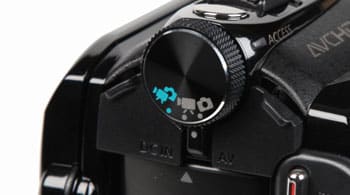
Auto Mode is confusingly called Dual Shot mode
The menu system on the DV1 is equally challenging. It isn't large compared to what you get on your average consumer camcorder (not an ultracompact model), but it is a lot more complex than the menus featured on a Flip camcorder. It's not the complexity of the menu that really bothers us, though, it is more the terrible design of the navigation controls on the back of the DV1. The d-pad buttons are small, close together, and difficult to use. This makes it nearly impossible to sift through the menus with ease, unless you have particularly tiny fingers (or you like pressing buttons with your fingernails).
Auto Mode
{{section_header}}{{section.name}}{{/section_header}}
Since there's no real manual controls on the GE DV1, the camcorder essentially functions in auto mode all the time. Making things even simpler, the DV1 has no autofocus mechanism due to its fixed lens. In order to shoot your subject in focus, all you must do is position the camcorder 1.5m (5 feet) away from what you're shooting. Shooting closer than that and your video images will look fuzzy and blurred (and those are just adjectives we're using to describe what "out of focus" looks like).
The DV1 generally exposes videos well, and you can set the auto exposure to use spot metering, face detection, or center-weighted average.
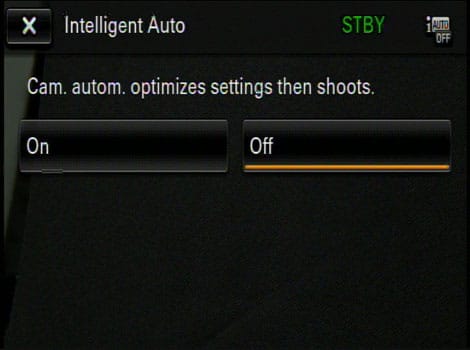
The iAuto mode button is difficult to find, but when you do find it the option for turning on the mode looks like this.
Auto Controls
{{section_header}}{{section.name}}{{/section_header}}
The controls and buttons on the back of the DV1 are not one of the camcorder's best features. The directional pad is of particular nuisance as it is too small and the buttons are too close together. Many times while attempting to zoom or sifting through the menus, we found ourselves accidentally bumping the record button or the wrong direction on the d-pad. This is a problem on many ultracompact models, but the DV1 is worse than most in this category. The hard buttons that flank the d-pad are also poorly designed, but they aren't quite as bad.
Handling
{{section_header}}{{section.name}}{{/section_header}}
One of the first things we noticed about the GE DV1 is that it felt heavy in our hand, despite the camcorder's small size. We aren't saying this weight is a bad thing, though, as the extra weight does make the camcorder easier to keep steady and balanced. What we don't like is the that the DV1 doesn't have any grippable surface or ergonomic structure. The camcorder is difficult to hold tightly in your hand and its surface is very slick—this is a model that may slip out of your hand easily. Thankfully, GE does ship a wrist strap along with the DV1. You can attach it via the small opening in the bottom of the camcorder.

The GE DV1 is also a very slow camcorder to respond to certain commands. This is most noticeable after you stop a recording session, as the camcorder then takes a few seconds of "thinking" before it returns to the record mode screen. One thing we do like about the DV1 is that it comes with a wall-plug adapter that allows you to run the camcorder while it is connected to a power outlet. This means you don't have to wait for the DV1 to charge before you can, say, connect it to a TV for video playback.

Some of the buttons on the DV1, particularly the menu/delete and shooting/playback buttons, are designed well. The d-pad in the center of the camcorder's backside, however, does not have a quality design. It is too small and it responds imprecisely when pressed. We counted numerous times when we wanted to press "left" on the d-pad, but it pressed record or "up" instead. GE should have made the d-pad larger, or, at least, given it more definable buttons.

If you're checking out the GE DV1, there's a good chance you're planning on doing some underwater videography. We did some testing with the camcorder underwater, and we found that it functioned adequately on the front end. The controls were still difficult to adjust, but are you really going to be making adjustments in the menu while you're snorkeling? We didn't think so.
So, on that front, the GE DV1 is a fine underwater camcorder. We couldn't test the DV1 with very deep submerging, but GE claims the camcorder should function fine up to 16 feet. One thing that made us a bit uncomfortable was the amount of water that seeped into the ports on the camcorder. No liquid entered the important zones, but water was definitely close to the memory card slot and HDMI ports when we opened the DV1 on dry land. There are little rubber barriers built into the port coverings that are meant to keep water from touching sensitive parts of the camcorder. The DV1's rubber barriers weren't quite as good as what we saw on the Kodak Playsport Zx3, and that's the reason there was a bit more water present when we opened the port covers. Just make sure you clean and dry the DV1 fairly soon after you're done using it in the water.

These dedicated buttons give you quick access to aperture and shutter speed controls.
Portability
{{section_header}}{{section.name}}{{/section_header}}
The GE DV1 is less than an inch thick and weighs around 1/3 of a pound. These are very portable specs for a waterproof ultracompact camcorder, but it isn't that much different than what we've come to expect in the pocket camcorder market. There are plenty of thinner and lighter camcorders than the DV1, while there are others that are bigger and heavier, but also handle a whole lot better than the DV1.
When it comes to portability with the GE DV1, it is very important to remember that the camcorder is waterproof up to 16 feet. This is deeper than the Kodak Playsport Zx3 and JVC GC-WP10 can travel, both of which can only be submerged safely in up to 10 feet of water according to their specs. Still, all that really matters in terms of portability is the fact that the DV1 is waterproof to begin with. This means you don't have to worry if you bring the camcorder out in the rain, to the beach, or hiking.
Battery Life
{{section_header}}{{section.name}}{{/section_header}}
Here's an area where GE clearly cut corners. The DV1 only lasted for 50 minutes in our battery life test—an inexcusably-low record time that is worse than any camcorder we've tested in recent memory. Making things worse, the battery on the DV1 is not removable and must be charged via the USB arm that swings out on the camcorder's left side. Because of this less-than-an-hour record time, we recommend using the DV1 sparingly if you're going to be away from a charging outlet for a while. One positive note, however, is that the DV1 comes with a wall-plug adapter that you can connect to the camcorder via a USB cable. This allows you to actually run the camcorder while it is plugged in, which is something you cannot do on numerous ultracompact models. More on how we test battery life.
The funniest thing about the DV1's terrible battery life performance is that the GE actually lists the camcorder's battery life as only 29 minutes in its specs. Thankfully, the battery lasted a bit longer than that, but we still consider any battery life that's less than an hour as unacceptable.

{{comparison_bars title="Battery Life Comparison", attribute="Battery Life Score", xLabel="minutes"}}
LCD
{{section_header}}{{section.name}}{{/section_header}}
The screen on the DV1 is a generous 2.5-inches in size, but the screen size is very deceiving. When you actually turn the camcorder on you'll see that only a small portion of the frame (maybe half) is used for framing and recording your video image. The bulk of the screen is full of meaningless data that the casual user would care less about. In playback mode you can view your images and videos in full screen by rotating the camcorder, but this is the only mode that allows you to fill the entirety of the screen with video content.
Stabilization
{{section_header}}{{section.name}}{{/section_header}}
The DV1 has a digital stabilization system (DIS), but the feature cannot be turned off, and that leaves us with no way to test its effectiveness. If this sounds silly, don't be alarmed. Having built-in DIS that can't be shut off is common on ultracompact camcorders. More on how we test stabilization.
Manual Focus
{{section_header}}{{section.name}}{{/section_header}}
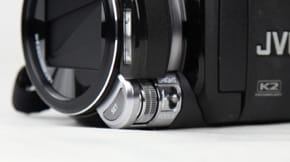
The adjustment dial makes accurate focus adjustments easy.
Manual Exposure
{{section_header}}{{section.name}}{{/section_header}}
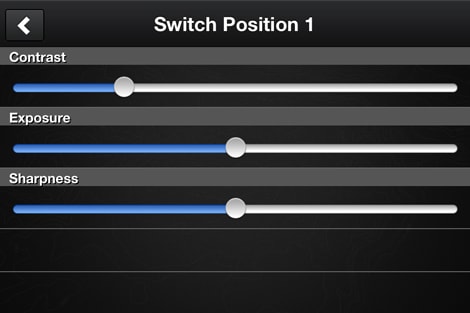
The manual exposure controls are only found on the Contour app, not on the camcorder itself.
Miscellaneous Controls
{{section_header}}{{section.name}}{{/section_header}}
High Dynamic Range
High Dynamic Range, which is abbreviated as HDR on the camcorder, should bring out more detail in shadowy portions of your videos and photos shot with the DV1. We found using the feature made little difference, though, and we weren't left all that impressed. We did find HDR to work decently outdoors at times, but it didn't help much under mixed lighting in an indoor setting.
Histogram
A live histogram can be displayed in record mode, and it is activated by pressing the display button on the directional pad (which, confusingly, is the left direction on the d-pad). We think histograms are kinda cool, but we don't expect there's many perspective users of the DV1 who are really hankering for this feature.
Auto Controls
{{section_header}}{{section.name}}{{/section_header}}
The controls and buttons on the back of the DV1 are not one of the camcorder's best features. The directional pad is of particular nuisance as it is too small and the buttons are too close together. Many times while attempting to zoom or sifting through the menus, we found ourselves accidentally bumping the record button or the wrong direction on the d-pad. This is a problem on many ultracompact models, but the DV1 is worse than most in this category. The hard buttons that flank the d-pad are also poorly designed, but they aren't quite as bad.
Audio Controls
{{section_header}}{{section.name}}{{/section_header}}
The GE DV1 can record audio with video, but, as far as audio features go, that's really all it is capable of. The built-in mic, which is poorly placed on the front of the camcorder next to the lens, records mono audio only. There are no audio connectivity features and the camcorder lacks any manual audio controls.
Editing
{{section_header}}{{section.name}}{{/section_header}}
The GE DV1 does come with some editing software, but there is no mention of this software in any of GE's provided instruction manuals. Further, it doesn't appear that any of the provided software applications allow for video editing—they only work with photos. QuickTime does come on the camcorder's provided software disc, but it is unclear if the version provided allows for basic video editing.
Other programs offered on the installation disc include ArcSoft MediaImpression and Adobe Acrobat Reader. The Acrobat Reader application seems to be on the disc so you can read the instruction manual, which is also found on the installation CD (a paper copy of the manual also comes with the camcorder). We didn't get the best "impression" from the ArcSoft MediaImpression software, but our disappointment was mainly relegated to the fact that the program did not allow us to edit or import video content from the GE DV1.
Confusingly, none of the software mentioned above come preloaded on the camcorder itself. If you connect the DV1 to a computer you will find a different piece of software entirely—Picasa, the photo editing and organization application from Google. This software can be loaded (PC only) onto your computer and is great for organizing and working with photos (again, no video application). Again, none of these programs are mentioned in the DV1's instruction manuals, so good luck figuring them out on your own.
Compression
{{section_header}}{{section.name}}{{/section_header}}
The GE DV1 uses MPEG-4 compression to record HD video. The camcorder also has two 720p recording options, a 1440 x 1080 record mode, and a standard definition video mode that records at a 640 x 480 resolution. Read more about the advantages and disadvantages of various high definition compression types.
Media
{{section_header}}{{section.name}}{{/section_header}}
The GE DV1 works with SD/SDHC memory cards, which are the standard memory card for consumer camcorders. The DV1 does not appear to be compatible with the new, higher-capacity SDXC memory cards, but we don't see this as too much of a problem. A couple of 16GB SDHC cards would store more than enough footage from the DV1 to satisfy the casual videographer.
The camcorder does have 27MB of internal memory, but you shouldn't rely on this for video. It's only enough space for a few seconds of HD content. Read more about the advantages and disadvantages of various media types.

Slow Motion Modes
Still Features
{{section_header}}{{section.name}}{{/section_header}}
The GE DV1 has basic still image features that allow the camcorder to capture photos at two different sizes: 2592 x 1944 (5 megapixels) and 2560 x 1440 (3 megapixels). You can also take photos during recording, but the size of the photo is limited to the same resolution you are recording the video. There are three image compression quality options—Best, Fine, and Normal—and the camcorder can use face detection in photo mode.
Most impressive is probably the DV1's continuous shooting mode. We can't think of another ultracompact camcorder that offers such a feature, so we're actually surprised GE decided to include it. According to the DV1's specs, the continuous shooting mode can take 7.3 photos per second when using the Fine image quality setting. One thing we noticed is that the camcorder is slow to react when you want to stop taking continuous photos. When you remove your finger from the photo button, the DV1 will continue to take still images for another second or two, so don't expect to get exactly the amount of photos that you were looking for each time.
Lens & Imaging System
{{section_header}}{{section.name}}{{/section_header}}

The lens and sensor specs for the GE DV1 are in line with a conventional ultracompact camcorder. By this we mean the DV1 has a large CMOS chip (1/2.5-inch) and a tiny lens with no optical zoom. This lack of optical zoom hurts the camcorder when it comes to quality and performance, mainly because it requires you to stand 1.5 meters (5 feet) away from your subject in order for it to be in focus. This is simply too far away in our book, and we prefer ultracompact camcorders that allow you to shoot as close to a subject as possible and still get an image that's in focus.
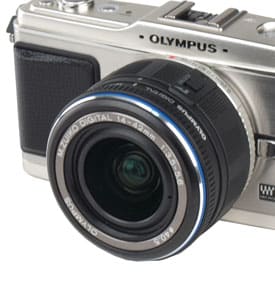
LCD
{{section_header}}{{section.name}}{{/section_header}}
The screen on the DV1 is a generous 2.5-inches in size, but the screen size is very deceiving. When you actually turn the camcorder on you'll see that only a small portion of the frame (maybe half) is used for framing and recording your video image. The bulk of the screen is full of meaningless data that the casual user would care less about. In playback mode you can view your images and videos in full screen by rotating the camcorder, but this is the only mode that allows you to fill the entirety of the screen with video content.
Connectivity
{{section_header}}{{section.name}}{{/section_header}}
GE crafted the DV1 with a built-in USB arm, thus making it part of the trend started by the Flip camcorder a few years ago. A slight difference here is that the USB arm on the GE DV1 has to be more protected due to the camcorder's waterproof design. To access the arm, you must first open a little door on the left side of the camcorder. Then you must flip a little yellow switch and—voila!—the USB arm is extended. Is this easy enough for your grandparents to figure out? Probably not right away, but if they're good with technology, and don't mind using their fingernails to flip tiny locks and switches, they should get accustomed to it after a few tries. Our point is that accessing something like a USB arm shouldn't be this difficult. It isn't nearly this hard on the Flip, and many other ultracompact models avoid this issue by having USB ports rather than built-in arm connectors.
Enough about the crummy USB arm on the DV1. Let's get to the positive connectivity features on the camcorder. Above the resting place for the USB connector, you'll find the HDMI output. We love seeing this output here, as HDMI is the best and most popular connection option for HDTV owners this day in age.
On the other side of the camcorder there's another flip-down door with a locking mechanism nearly identical to what you get on the left. Behind this door is just one connectivity feature: the SD/SDHC memory card slot. The slot, like most of the connectivity features on the DV1, is cramped. This makes it hard to get your cards in and out, although we are happy to see the door cover and lock over the card slot very well. This keeps the water out when the camcorder is submerged (and that's a good thing).
Battery
{{section_header}}{{section.name}}{{/section_header}}
The funniest thing about the DV1's terrible battery life performance is that the GE actually lists the camcorder's battery life as only 29 minutes in its specs. Thankfully, the battery lasted a bit longer than that, but we still consider any battery life that's less than an hour as unacceptable.

Media
{{section_header}}{{section.name}}{{/section_header}}
The GE DV1 works with SD/SDHC memory cards, which are the standard memory card for consumer camcorders. The DV1 does not appear to be compatible with the new, higher-capacity SDXC memory cards, but we don't see this as too much of a problem. A couple of 16GB SDHC cards would store more than enough footage from the DV1 to satisfy the casual videographer.
The camcorder does have 27MB of internal memory, but you shouldn't rely on this for video. It's only enough space for a few seconds of HD content. Read more about the advantages and disadvantages of various media types.

Still Features
{{section_header}}{{section.name}}{{/section_header}}
The GE DV1 has basic still image features that allow the camcorder to capture photos at two different sizes: 2592 x 1944 (5 megapixels) and 2560 x 1440 (3 megapixels). You can also take photos during recording, but the size of the photo is limited to the same resolution you are recording the video. There are three image compression quality options—Best, Fine, and Normal—and the camcorder can use face detection in photo mode.
Most impressive is probably the DV1's continuous shooting mode. We can't think of another ultracompact camcorder that offers such a feature, so we're actually surprised GE decided to include it. According to the DV1's specs, the continuous shooting mode can take 7.3 photos per second when using the Fine image quality setting. One thing we noticed is that the camcorder is slow to react when you want to stop taking continuous photos. When you remove your finger from the photo button, the DV1 will continue to take still images for another second or two, so don't expect to get exactly the amount of photos that you were looking for each time.
Other Features
{{section_header}}{{section.name}}{{/section_header}}
Waterproof
We've talked about the GE DV1's waterproof capability throughout this review, but we'll recap everything here as well. The camcorder is waterproof up to 16 feet (5m), and GE claims the DV1 should operate fine in temperatures ranging from 32 - 104 degrees Fahrenheit (0 - 40 Celsius). The specs also claim the DV1 can work in environments of up to 90% humidity.
The camcorder is shockproof up to 5 feet (1.5m), which means it should be able to withstand your average drop or slip from your hand. GE also claims the DV1 is dustproof according to the JIS/IEC standards. We're not exactly sure what this means, but we assume it has something to do with dust resistance.
JVC Picsio GC-WP10 Comparison
The Kodak Playsport Zx3 is one of our favorite ultracompact camcorders, and we're excited to review its second-generation model (the Playsport Zx5) in the coming weeks. For now, however, we'll have to compare the GE DV1 to the first Playsport camcorder. Even with the Zx3 being an older model, it's still the better camcorder by far. The Playsport Zx3 is only waterproof up to 10 feet (that's 6 fewer feet than the GE DV1), but it handles a whole lot better than the DV1 and it did a better job in our video testing (particularly in low light).
Both the Playsport and the DV1 suffer from poor menu design and confusing displays, but at least Kodak made the interface simpler on the Playsport. The camcorder's dedicated buttons feel good, and its overall construction offers a solid grip and water-repelling design. We also like the port covers on the Zx3 better than the tricky ones found on the DV1.
In all, we simply like the way the Playsport Zx3 felt in our hand a whole lot more than the GE DV1. The Playsport did better in our testing as well, but it was the handling and user interface that really won us over. The GE DV1 does have one benefit, though—it retails for $20 less than the Playsport Zx3.
Panasonic HM-TA1 Comparison
The JVC GC-WP10 is not a good camcorder, but even it was able to edge the GE DV1 in our testing. The WP10 did better in low light, produced a slightly sharper image, and packs in a few more features that are absent on the DV1. Still, the WP10 is a bulkier camcorder than the GE DV1 and it is just as awkward to hold and control. Both camcorders suffer from slow response times, confusing interfaces, and clumsy designs.
Honestly, we can't recommend either of these models—particularly when the Kodak Playsport Zx3 is better on nearly all accounts. The JVC GC-WP10 is the only model of the three that uses a touchscreen interface, but we really did not enjoy working with it one bit. If JVC could improve some aspects of the touchscreen and user experience, then maybe the next iteration of the WP10 will be commendable. For now, it sits on the same second-rate pedestal as the GE DV1.
COMP 3
The Panasonic HM-TA1 was a major disappointment last year. But, even with its setbacks, the TA1 is a better camcorder than the GE DV1. Where the TA1 succeeds is in performance. Although it wasn't the best ultracompact camcorder we tested, the TA1 did do reasonably well in all of our performance tests. Where the camcorder fails, however, is in design. The TA1 feels cheap, breaks easily, and does not have a rugged waterproof design like the GE DV1, Kodak Playsport Zx3, or the JVC Picsio GC-WP10.
If you're not in the market for a waterproof camcorder, the best competition against the HM-TA1 is either a Flip camcorder or a Sony Bloggie model. The new Sony Bloggie Touch camcorders are sleek and stylish and did well on many of our video performance tests. The Flip cams don't have nearly as good performance, but they are the simplest camcorders on the market. We'd recommend the Flip or the Sony Bloggie Touch over the Panasonic HM-TA1.
Comparing the TA1 to the DV1 is more difficult. Both have serious design flaws, but we like the durability provided by the DV1. While the Panasonic HM-TA1 originally retailed for $169, the price has dropped significantly since the camcorder's launch. It can now be found online for as low as $90. For this reason, we think the HM-TA1 is a better deal than the GE DV1—but only if you have no need for a waterproof frame. Overall, we don't recommend either camcorder too highly. The Kodak Playsport Zx3 and the aforementioned Flip and Sony Bloggie Touch models are much better.
Conclusion
The GE DV1 frustrated us from the moment we took it out of the box, but there were a few things that we liked about the camcorder as well. Let's start with the bad: the camcorder has a clumsy design, poor video performance, confusing controls, bad buttons, and a terrible instruction manual. We found the port covers to be difficult to open and the built-in USB arm was a particular challenge to extract.
The good things about the camcorder? We liked its 16-foot waterproof capabilities that went above and beyond (or should we say below and beyond?) that of the Kodak Playsport Zx3 and JVC GC-WP10. We also liked that it came with a USB extension cable and a USB-wall-plug adapter that lets you run the camcorder while it is plugged into a power outlet. The fact that the DV1 is available in the fun colors of aqua blue, citrus orange, graphite gray, lime green, or velvet red is commendable as well.
In all, we wouldn't place the GE DV1 on a higher tier than the Kodak Playsport Zx3, but we would put it in roughly the same category as the JVC GC-WP10 and Panasonic HM-TA1. It is a flawed waterproof camcorder that is available at a low price. If you want good video quality or top-notch handling, you should look elsewhere.
Photo Gallery
{{photo_gallery "Front Photo", "Left Photo", "Left Open Photo", "Back Photo", "Right Photo", "Top Photo", "Bottom Photo", "Lens Photo", "Lens Photo 2", "3D Lens Photo", "Media Photo", "Easy Mode Photo", "Manual Controls Photo", "Zoom Photo", "Zoom Photo 2", "Ease of Use Photo", "Battery Photo", "LCD Photo 1", "LCD Photo 2", "EVF Photo 1", "EVF Photo 2", "Mic Photo", "Mic Photo 2", "Ports Photo 1", "Ports Photo 2", "Ports Photo 3", "Ports Photo 4", "Ports Photo 5", "Ports Photo 6", "Handling Photo 1", "Handling Photo 2", "Handling Photo 3", "Handling Photo 4", "Box Photo"}}
Meet the tester
Jeremy is the video expert of our imaging team and Reviewed.com's head of video production. Originally from Pennsylvania and upstate NY, he graduated from Bard college with a degree in film and electronic media. He has been living and working in New England since 2005.
Checking our work.
Our team is here to help you buy the best stuff and love what you own. Our writers, editors, and experts obsess over the products we cover to make sure you're confident and satisfied. Have a different opinion about something we recommend? Email us and we'll compare notes.
Shoot us an email